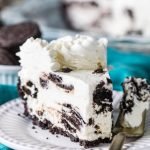A Simple, Homemade Lemon Tart
Making up for the dreary weather we’ve been having recently with this bright and sunny lemon tart.
It’s pure sunshine with a crisp, buttery crust cradling a silky-smooth lemon curd filling that’s equally tangy and sweet. Top it off with a fluffy cloud of homemade whipped cream and just try to keep yourself from going back for a second slice. Resistance/willpower… a skill I’m yet to master 🥴
I used to find tarts to be intimidating, but they are honestly simple to make and not much different than a pie. The most difficult part is having patience, as it will have to chill in the fridge overnight before serving, so keep that in mind if you’re making it for an event. On that note, it’s perfect for making in advance!
My recipe includes three well-balanced layers:
- Pâte sucrée crust: Tender, sweet, and buttery pastry that holds up well against the creamy filling. It’s sweeter than traditional pie crust and tastes similar to a shortbread cookie. It would be delicious on its own, but of course we’re going to be filling it with…
- A rich, tangy lemon filling: A delightful balance of sweetness and tanginess that sets up just firm enough to neatly slice. This is essentially the same filling used in my lemon bars.
- Optional whipped cream topping: Adds a light, creamy finish that tempers the tartness of the lemon. This can be piped or dolloped to suit your preferred presentation style. I piped it prettily for pictures, but in reality I typically just plop a large spoonful on top of my slice before enjoying.
What You Need
Use high-quality ingredients ensures a vibrant, delicious, and beautifully textured lemon tart. Specifically, you will need:
- Butter. Use unsalted butter and make sure it’s super cold before you add it to the crust (you can even place it in the freezer for 10-15 minutes beforehand). If you can find it and want to spring for it, European butter works very nicely here!
- Eggs. We’ll use eggs in both the crust and the filling. For the crust, make sure your egg is chilled before adding it. For the filling, we’ll use two whole eggs and a few extra yolks. If you’d like to use your leftover egg whites instead of throwing them away, you can use them to make meringue cookies, French macarons, or a batch of marshmallow frosting. You could even use it to make a meringue to top off the pie (like you would a lemon meringue pie), but I prefer to use whipped cream instead.
- Lemons. Squeeze your own lemons! The bottled stuff just doesn’t come close flavor-wise (I had a few family members who insisted it didn’t make a difference, but a taste-test left me vindicated, and Bon Appetit also validates my claim, discussing the oxidation of the bottled stuff and whatnot) . This is critical, and I only guarantee tasty results if you follow this rule 😉
- Powdered sugar. We’ll use a bit of powdered sugar in the crust for tender, shortbread-esque results.
- Vanilla extract. I don’t use any vanilla in the filling as it undermined the lemon flavor rather than flattered it, but a splash in the crust and the whipped cream on top does accent the filling nicely.
This is just an overview of the ingredients I used and why. For the full recipe please scroll down to the bottom of the post!
How to Make Lemon Tart
Make the tart crust (pâte sucrée)
- Pulse together the flour, sugar, and salt in a food processor, then add the butter and pulse again until coarse crumbs form.
- Combine the egg and vanilla (I whisk them together in a small dish to evenly distribute the vanilla extract) then pour into the food processor and pulse until the dough begins to cling together.
- Form the dough into a disc, wrap in plastic (or parchment paper), and place in the fridge to chill for 1 hour. See those specks throughout the dough in the photos above? That’s butter, you want to see that!
- Roll the dough into a 10-11″ circle before pressing into a 9″ tart pan. Tip for when you’re rolling out your dough: do so on a floured surface and periodically use a spatula to scrape up the bottom of the dough to keep it from sticking. To transfer the dough to the tart pan, simply roll it up around your rolling pin then unroll it over the tart pan (I demonstrate this in my video).
Bake the crust
- Prick the bottom of the crust all over with a fork, cover with parchment paper, and fill with pie weights. I crumple (and un-crumple) my parchment paper several times so that it fits nicely in the pie shell. Chill in the freezer for 30 minutes.
- Bake the crust for 20 minutes at 375F, then carefully remove the parchment and pie weights and bake for another 5 minutes/until light browning occurs.
Prepare the Filling
- Whisk together all ingredients except the butter in a medium sized pot. Add the butter and turn the heat to medium low.
- Stir constantly while the mixture cooks. Once it thickens and coats the back of a spoon, remove the curd from the heat.
- Pour the filling through a fine mesh strainer into a heatproof bowl, then pour into your tart crust. The strainer is key, it filters out any impurities, seeds, or small bits of cooked egg that may have occurred. You need to use one for a silky smooth filling.
- Evenly spread the filling into the crust, and smooth the surface. Let cool at room temperature for one hour, then transfer to the fridge for at least 6 hours.
Whipped Cream
- Whip the cream, powdered sugar, and vanilla until stiff peaks form.
- Spread or pipe onto the chilled tart, slice, and enjoy!






